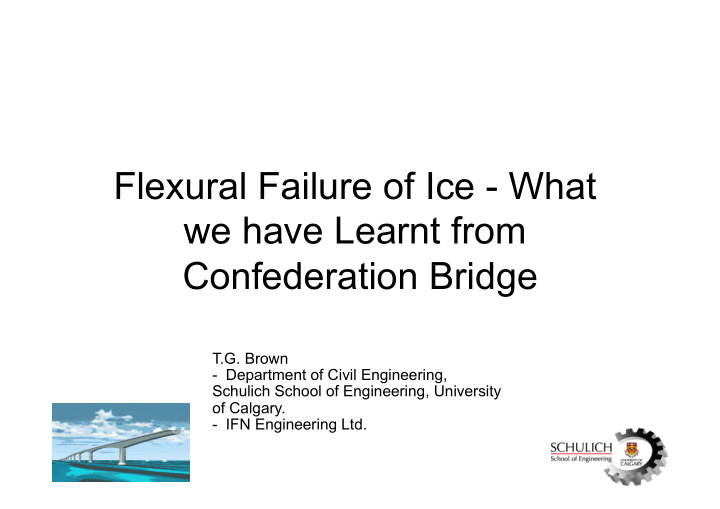



Flexural Failure of Ice - What we have Learnt from Confederation Bridge T.G. Brown - Department of Civil Engineering, Schulich School of Engineering, University of Calgary. - IFN Engineering Ltd.
Outline Confederation Bridge and Ice in Northumberland Strait. The monitoring programme. Ice force measurement. Observations related to flexural failure. Flexural failure loads, measurements and predictions. Sidebar – ridges. Conclusions.
Confederation Bridge
Confederation Bridge
Confederation Bridge
Ice in Northumberland Strait
Ice in Northumberland Strait Synthetic Aperture Radar Image of Ice in Northumberland Strait, 1988.
Typical Ice Conditions
Why is Confederation Bridge a good site for ice observations? • Ice is present for 100 to 120 days every year • Each pier “sees” something like 3000 km of ice a year. • Which means that each pier encounters something of the order of 9000 ridges a year. • Ice floe diameters typically to 2 km but we have seen one floe measuring 5 km by 8 km • Level ice thicknesses to about 1 meter
Why is Confederation Bridge a good site for ice observations? • Ice speeds have been measured to 1.6 m/sec • Ice is wind and tidal current driven, hence much pressure in plane of ice cover • Ridge keel depths have been measured to 16 m. • Consolidated ice thicknesses measured to 2.5 m.
Monitoring Programme Elements • Ice forces were the controlling lateral load condition • Bridge designed to a Beta factor of 4.25 for single path load systems – annual probability of failure of ~10 -7 • Uncertainty regarding design ice forces: – Estimates ranged from 16 to 33 MN for unfactored 100-year design force!! • So: – Measure ice forces – Measure ice pressures – Observe behaviour of ice against piers – Measure related ice and environmental parameters
Measurements • Confederation Bridge, we measure: – Tilt response of piers, and – Acceleration response of piers • Advantages: – Highly accurate – Dynamic sensitivity • Disadvantages: – Response contaminated by structure response to ice and other dynamic load effects – Attenuation of tiltmeter signal at frequencies >2 Hz – How to calibrate? – Measure pressures – View interactions
Kinematic Instrumentation Biaxial Tiltmeter Accelerometers
Ice pressures Cone Panels Tapered to Match Conical Surface 1.575m 0m -1.575m -5m Each Panel 1m by 2m (Typ.) -9m -10m -14m
Behaviour • Closed-Circuit TV • Time-lapse recording • Focus on two piers • Initially analogue • Now digital
Kinematic Instrumentation +24.56m +24.56m Group 4 Group 4 Sensor Locations Sensor Locations Spare Spare Group 3 Group 3 +3.20m +3.20m 78° 78° 4.0 m 4.0 m 52° 52° 10.0 m . 10.0 m .
Calibration
Calibration
Then the rope broke! • Video taken during the pull test in 1997 showing the rope breaking.
And we got: 0.1 0.08 0.06 0.04 0.02 0 135 140 145 150 155 160 -0.02 -0.04 -0.06 -0.08 -0.1
Ice Flexural Behaviour
Flexural failure • Analysis of video imagery – Rubble piles and ride-up – Extent of both phenomena – Dynamics of rubble pile • Analysis of cone panel data – Circumferential distribution – Slope distribution • Analysis of load traces – Actual loads – Dynamics of loads
Rubble Piles
Ride-Up
Maximum ride-up
Rubble under ice sheet
Recommend
More recommend